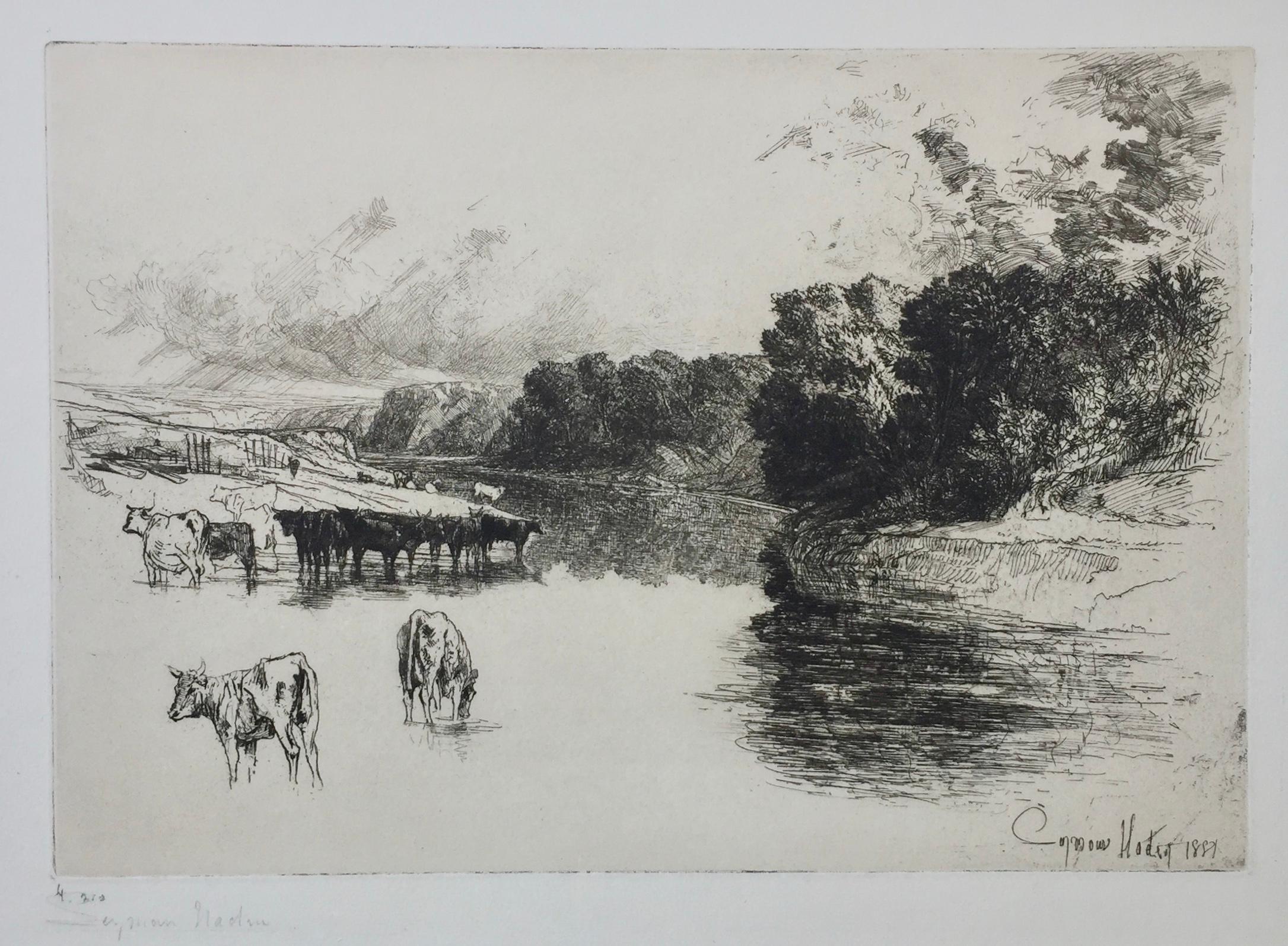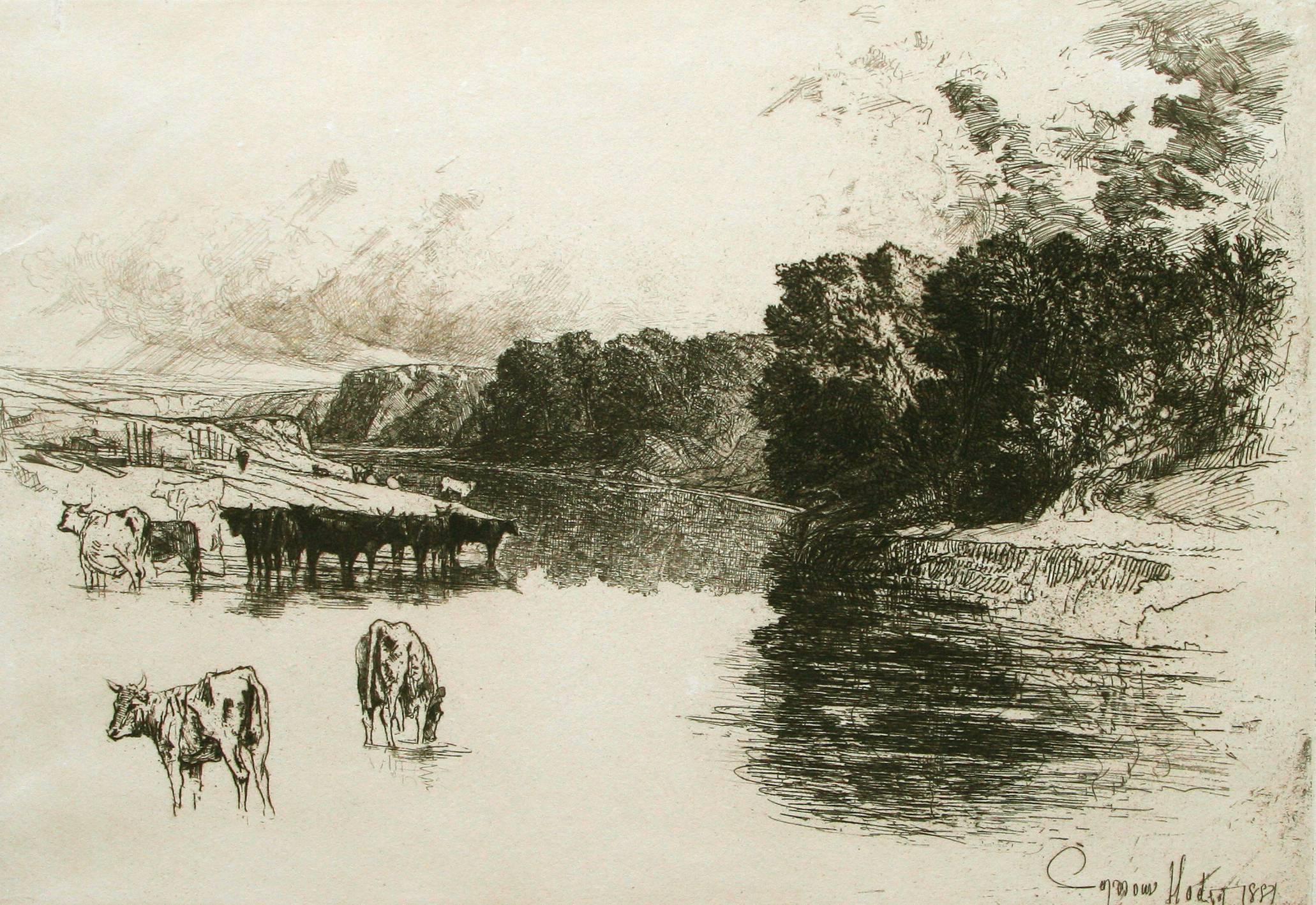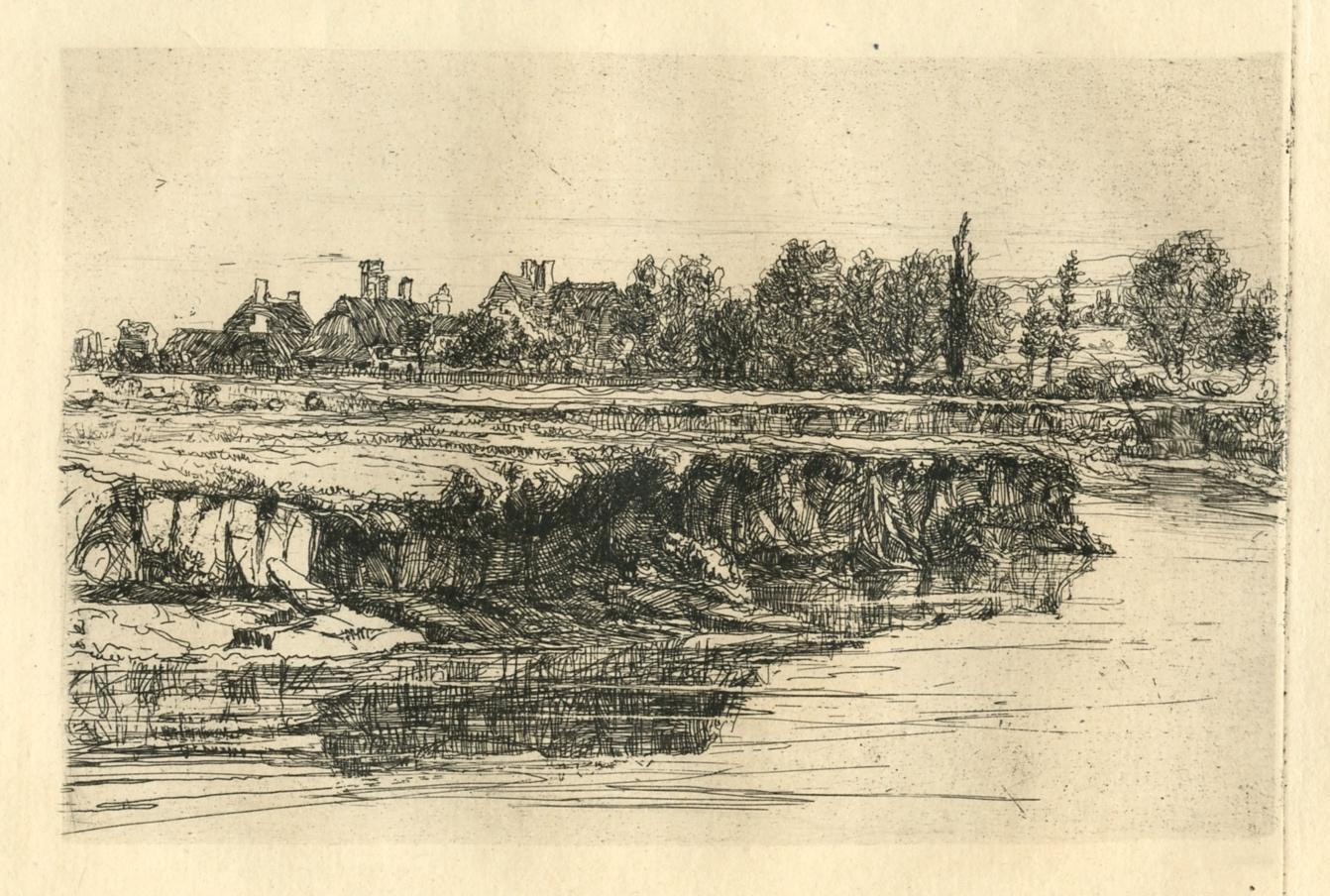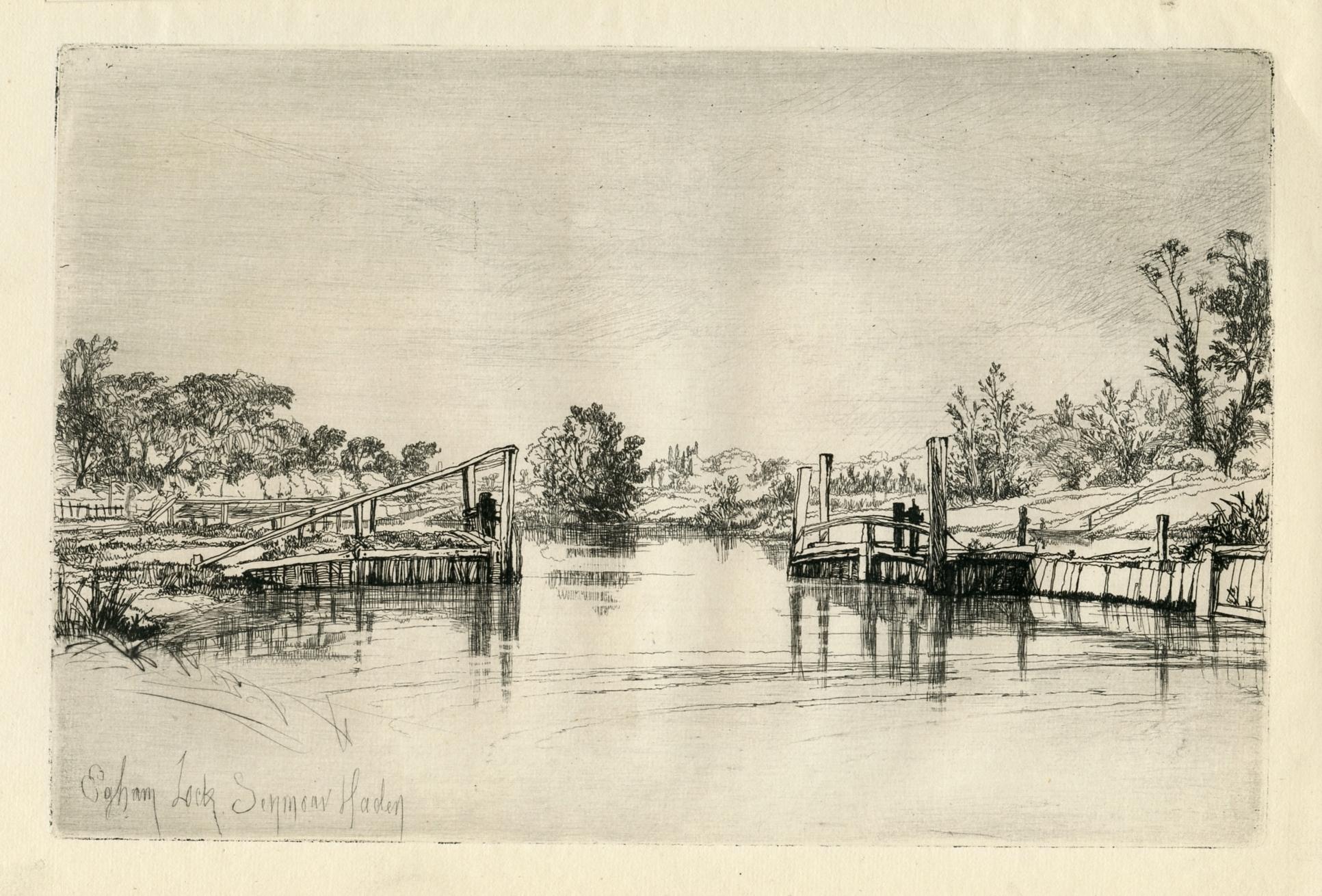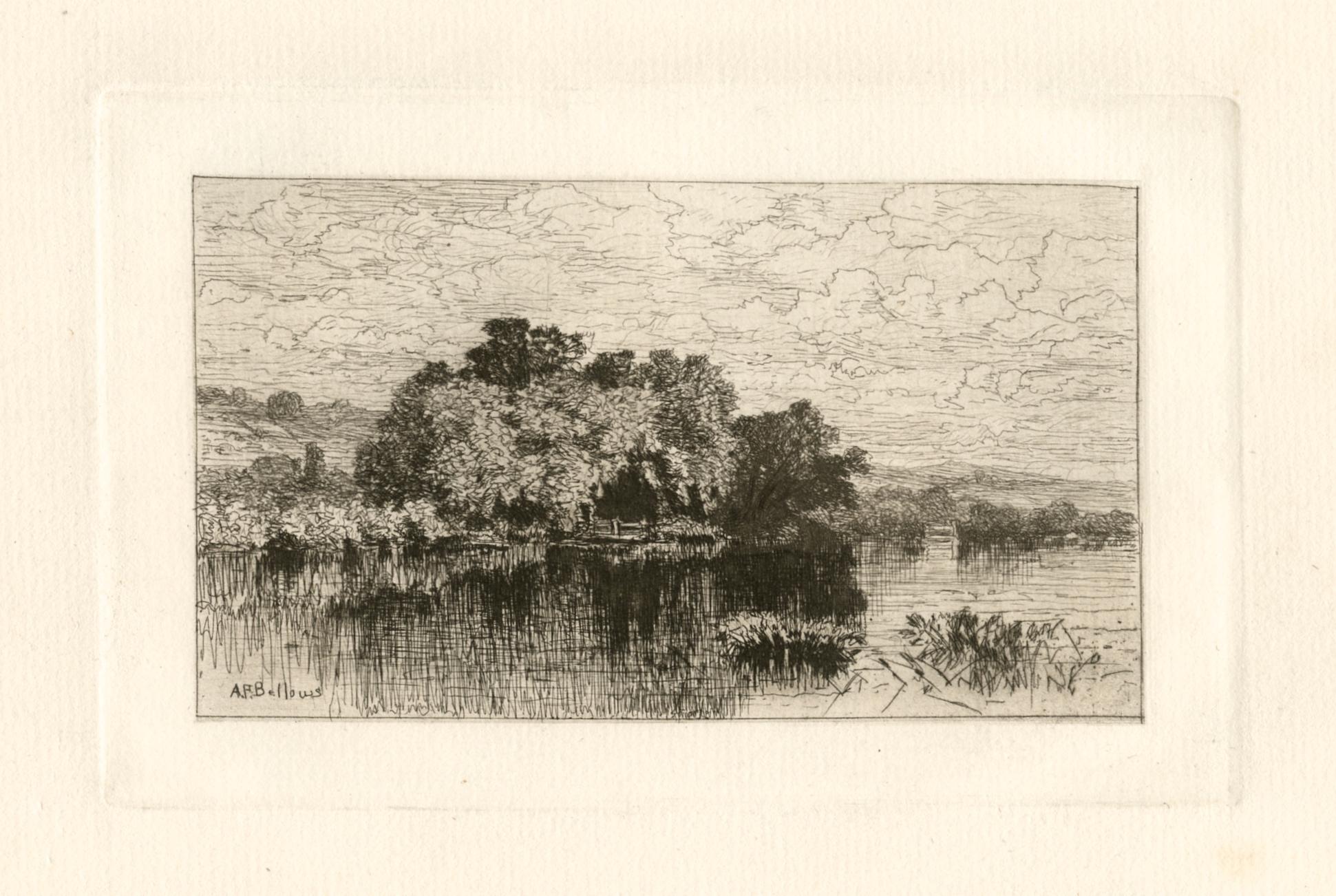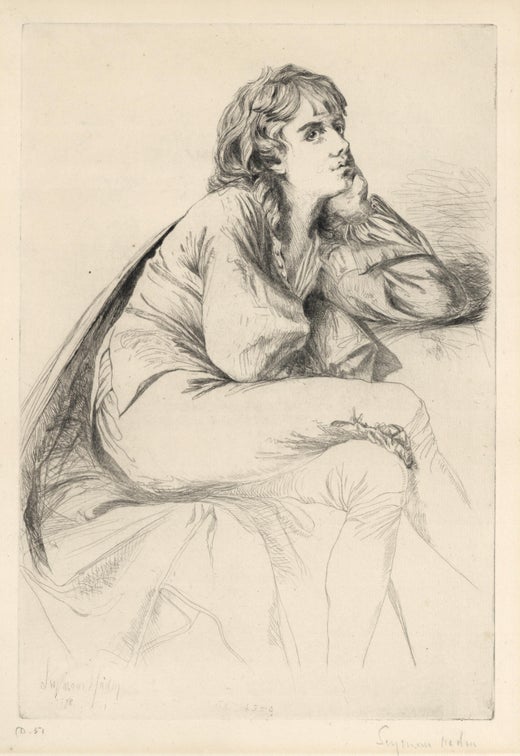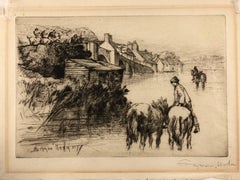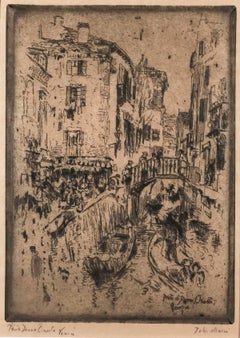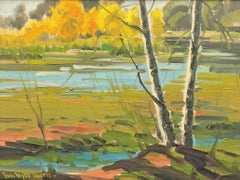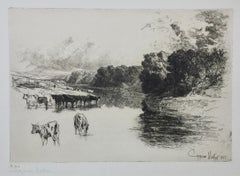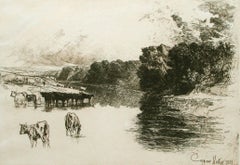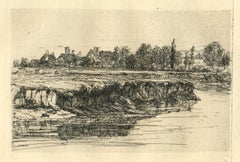Items Similar to Shere Mill Pond
Video Loading
Want more images or videos?
Request additional images or videos from the seller
1 of 11
Sir Francis Seymour Haden, R.A.Shere Mill Pond1860
1860
$750
£568.27
€652.04
CA$1,055.37
A$1,160.14
CHF 609.72
MX$14,088.36
NOK 7,606.08
SEK 7,206.23
DKK 4,866.35
About the Item
Shere Mill Pond, No. II (large plate). 1860. Etching and drypoint. Schneiderman 37.v/ix. 7 x 13 1/8 (sheet 10 3/4 x 16 3/8). This state is prior to publication in Études à l'Eau-Forte. Illustrated: Keppel The Golden Age of Engraving; Print Collector's Quarterly 1 (1911): 18; : Guichard, British Etchers, 1850-1940. A rich, brilliant proof with drypoint burr printed on white laid paper. Signed in pencil.
-------------------------------------------------------------------------------------------
Shere Mill Pond, No. II was one of the most highly praised landscape prints of the etching revival. An impression was exhibited at the Royal Academy in 1861 under Haden’s pseudonym, H. Dean. Francis Seymour Haden used this anagram of his own name early in his career as an artist, in order to retain his anonymity and preserve his professional reputation as a surgeon.
Biography:
Sir Francis Seymour Haden (16 September 1818 - 1 June 1910), was an English surgeon, best known as an etcher.
He was born in London, his father, Charles Thomas Haden, being a well-known doctor and lover of music. He was educated at Derby School, Christ's Hospital, and University College, London, and also studied at the Sorbonne, Paris, where he took his degree in 1840. He was admitted as a member of the College of Surgeons in London in 1842.
In 1843-1844, with his friends Duval, Le Cannes and Colonel Guibout, he travelled in Italy and made his first sketches from nature. Haden attended no art school and had no art teachers, but between 1845 and 1848 he studied portfolios of prints belonging to a second-hand dealer named Love, who had a shop in Bunhill Row, the old Quaker quarter of London. Arranging the prints in chronological order, he studied the works of the great original engravers, Albrecht Dürer, Lucas van Leyden and Rembrandt. These studies, besides influencing his original work, led to his important monograph on the etched work of Rembrandt. By lecture and book, and with the aid of the memorable exhibition at the Burlington Fine Arts Club in 1877, he tried to give a true reflection of Rembrandt's work, giving a nobler idea of the master's mind by taking away from the list of his works many dull and unseemly plates that had long been included in the lists. His reasons were founded upon the results of a study of the master's works in chronological order, and are clearly expressed in his monograph, The Etched Work of Rembrandt critically reconsidered, privately printed in 1877, and in The Etched Work of Rembrandt True and False (1895).
Haden's printmaking was invigorated by his much younger brother-in-law, James Whistler, at the Haden home in Sloane Street in 1855. A press was installed there and for a while Haden and Whistler collaborated on a series of etchings of the Thames. The relationship and project did not last.
Haden followed the art of original etching with such vigour that he became not only the foremost British exponent of that art but brought about its revival in England. His strenuous efforts and perseverance, aided by the secretarial ability of Sir WR Drake, resulted in the foundation of the Royal Society of Painter-Etchers and Engravers. As president he ruled the society with a strong hand from its first beginnings in 1880.
Notwithstanding his study of the old masters of his art, Haden's own plates were very individual, and are particularly noticeable for a fine original treatment of landscape subjects, free and open in line, clear and well divided in mass, and full of a noble and dignified style of his own. Even when working from a picture his personality dominates the plate, as for example in the large plate he etched after J.M.W. Turner's "Calais Pier," which is a classical example of what interpretative work can do in black and white. Of his original plates, more than 250 in number, one of the most notable was the large "Breaking up of the Agamemnon."
An early plate, rare and most beautiful, is "Thames Fisherman". "Mytton Hall" is broad in treatment, and a fine rendering of a shady avenue of yew trees leading to an old manor-house in sunlight. "Sub Tegmine" was etched in Greenwich Park in 1859; and "Early Morning--Richmond", full of the poetry and freshness of the hour, was done, according to Haden, actually at sunrise. One of the rarest and most beautiful of his plates is "A By-Road in Tipperary"; "Combe Bottom" is another; and "Shere Mill Pond" (both the small study and the larger plate), "Sunset in Ireland," "Penton Hook," "Grim Spain" and "Evening Fishing, Longparish," are also notable examples of his genius. A catalogue of his works was begun by Sir William Drake and completed by Harrington in 1880. During later years Haden began to practise the sister art of mezzotint engraving, with a measure of the same success that he had already achieved in pure etching and in dry-point. Some of his mezzotints are: "An Early Riser," a stag seen through the morning mists, "Grayling Fishing" and "A Salmon Pool on the Spey." He also produced some remarkable drawings of trees and park-like country in charcoal.
Other books by Haden not already mentioned are:
• Etudes a l'eau forte (Paris, 1865)
• About Etching (London, 1878-1879)
• The Art of the Painter-Etcher (London, 1890)
• The Relative Claims of Etching and Engraving to rank as Fine Arts and to be represented in the Royal Academy (London, 1883)
• Address to Students of Winchester School of Art (Winchester, 1888)
• Cremation: a Pamphlet (London, 1875)
• The Disposal of the Dead, a Plea for Legislation (London, 1888).
As the last two indicate, he was an ardent champion of a system of "earth to earth" burial.
Among numerous distinctions he received the Grand Prix, Paris, in 1889 and 1900, and was made a member of the Institut de France, Académie des Beaux-Arts and Société des Artistes Français. He was knighted in 1894. He married in 1847 a sister of the artist James McNeill Whistler; and his elder son, Francis Seymour Haden (b. 1850), had a distinguished career as a member of the government in Natal Colony from 1881 to 1893, being made a C.M.G. in 1890.
- Creator:Sir Francis Seymour Haden, R.A. (1818 - 1910, British)
- Creation Year:1860
- Dimensions:Height: 11 in (27.94 cm)Width: 17 in (43.18 cm)
- Medium:
- Movement & Style:
- Period:
- Condition:
- Gallery Location:Missouri, MO
- Reference Number:1stDibs: LU74732268851
Sir Francis Seymour Haden, R.A.
Sir Francis Seymour Haden CMG FRCS PPRE (16 September 1818 – 1 June 1910), was an English surgeon, best known as an original etcher who championed original printmaking. He was at the heart of the Etching Revival in Britain, and one of the founders of the Society of Painter-Etchers, now the Royal Society of Painter-Printmakers, as its first president. He was also a collector and scholar of Rembrandt's prints.
About the Seller
5.0
Vetted Professional Seller
Every seller passes strict standards for authenticity and reliability
Established in 1970
1stDibs seller since 2017
155 sales on 1stDibs
Typical response time: Several days
- ShippingRetrieving quote...Shipping from: Missouri, MO
- Return Policy
Authenticity Guarantee
In the unlikely event there’s an issue with an item’s authenticity, contact us within 1 year for a full refund. DetailsMoney-Back Guarantee
If your item is not as described, is damaged in transit, or does not arrive, contact us within 7 days for a full refund. Details24-Hour Cancellation
You have a 24-hour grace period in which to reconsider your purchase, with no questions asked.Vetted Professional Sellers
Our world-class sellers must adhere to strict standards for service and quality, maintaining the integrity of our listings.Price-Match Guarantee
If you find that a seller listed the same item for a lower price elsewhere, we’ll match it.Trusted Global Delivery
Our best-in-class carrier network provides specialized shipping options worldwide, including custom delivery.More From This Seller
View AllWareham Bridge
By Seymour Haden
Located in Missouri, MO
Wareham Bridge
Medium Drypoint
Year of Work 1877-1877
Image Size: approx. 6 in.; Width 8.9 in. / Height 15.2 cm.; Width 22.7 cm.
Sir Francis Seymour Haden (16 September 1818 - 1 June 1910), was an English surgeon, best known as an etcher.
He was born in London, his father, Charles Thomas Haden, being a well-known doctor and lover of music. He was educated at Derby School, Christ's Hospital, and University College, London, and also studied at the Sorbonne, Paris, where he took his degree in 1840. He was admitted as a member of the College of Surgeons in London in 1842.
In 1843-1844, with his friends Duval, Le Cannes and Colonel Guibout, he travelled in Italy and made his first sketches from nature. Haden attended no art school and had no art teachers, but between 1845 and 1848 he studied portfolios of prints belonging to a second-hand dealer named Love, who had a shop in Bunhill Row, the old Quaker quarter of London. Arranging the prints in chronological order, he studied the works of the great original engravers, Albrecht Dürer, Lucas van Leyden and Rembrandt. These studies, besides influencing his original work, led to his important monograph on the etched work of Rembrandt. By lecture and book, and with the aid of the memorable exhibition at the Burlington Fine Arts Club in 1877, he tried to give a true reflection of Rembrandt's work, giving a nobler idea of the master's mind by taking away from the list of his works many dull and unseemly plates that had long been included in the lists. His reasons were founded upon the results of a study of the master's works in chronological order, and are clearly expressed in his monograph, The Etched Work of Rembrandt critically reconsidered, privately printed in 1877, and in The Etched Work of Rembrandt True and False (1895).
Haden's printmaking was invigorated by his much younger brother-in-law, James Whistler, at the Haden home in Sloane Street in 1855. A press was installed there and for a while Haden and Whistler collaborated on a series of etchings of the Thames. The relationship and project did not last.
Haden followed the art of original etching with such vigour that he became not only the foremost British exponent of that art but brought about its revival in England. His strenuous efforts and perseverance, aided by the secretarial ability of Sir WR Drake, resulted in the foundation of the Royal Society of Painter-Etchers and Engravers. As president he ruled the society with a strong hand from its first beginnings in 1880.
Notwithstanding his study of the old masters of his art, Haden's own plates were very individual, and are particularly noticeable for a fine original treatment of landscape subjects, free and open in line, clear and well divided in mass, and full of a noble and dignified style of his own. Even when working from a picture his personality dominates the plate, as for example in the large plate he etched after J.M.W. Turner's "Calais Pier," which is a classical example of what interpretative work can do in black and white. Of his original plates, more than 250 in number, one of the most notable was the large "Breaking up of the Agamemnon."
An early plate, rare and most beautiful, is "Thames Fisherman". "Mytton Hall" is broad in treatment, and a fine rendering of a shady avenue of yew trees leading to an old manor-house in sunlight. "Sub Tegmine" was etched in Greenwich Park in 1859; and "Early Morning--Richmond", full of the poetry and freshness of the hour, was done, according to Haden, actually at sunrise. One of the rarest and most beautiful of his plates is "A By-Road in Tipperary"; "Combe Bottom" is another; and "Shere Mill Pond" (both the small study and the larger plate), "Sunset in Ireland," "Penton Hook," "Grim Spain" and "Evening Fishing, Longparish," are also notable examples of his genius. A catalogue of his works was begun by Sir William Drake and completed by Harrington in 1880. During later years Haden began to practise the sister art...
Category
1870s Other Art Style Landscape Prints
Materials
Etching
Ponte di Donna Onesta, Venice
By John Marin
Located in Missouri, MO
Very rare etching by John Marin.
"Ponte di Donna Onesta, Venice" 1907
Original Etching
Hand Signed Lower Right
Titled Lower Left
Edition: c. 30
Cat. Rais: ...
Category
Early 1900s Abstract Landscape Prints
Materials
Etching
Price Upon Request
Along the River
By Samuel Hyde Harris
Located in Missouri, MO
By the great California Impressionist, Samuel Hyde Harris.
"Along the River" c. 1930s
Oil on Board
Signed Lower Left
Image Size: 12 x 16 inches
Framed...
Category
1930s American Impressionist Landscape Paintings
Materials
Oil, Board
Price Upon Request
A Day in June, Scene Eastchest, New York
By Edward B. Gay
Located in Missouri, MO
"A Day in June, Scene Eastchest, New York" 1898
Edward Gay (Irish, American, 1837-1928)
Oil on Canvas
Complimented by original frame in great condition
Signed and Dated Lower Right
T...
Category
1890s Hudson River School Landscape Paintings
Materials
Canvas, Oil
Harmonville
By Daniel Garber
Located in Missouri, MO
DANIEL GARBER
"Harmonville, Pennsylvania" c. 1925
Etching printed in black ink on wove paper.
7 7/8 x 11 3/4 inches, full margins.
Signed, titled and inscribed "DG imp" in pencil, ...
Category
1920s American Impressionist Landscape Prints
Materials
Etching
Price Upon Request
Springtime at the Farm
Located in Missouri, MO
George W. Drew (1875-1968)
"Springtime at the Farm"
Oil on Canvas
24 x 36 inches (site)
31.5 x 43.25 (framed)
George W. Drew was born 21 December 1875 in Massachusetts. He was a member of the Independent Artists Association. He exhibited at the National Academy of Design and they have him recorded as living at 745 Columbus Ave., N.Y. in the year 1898. He also exhibited at the Allied Artists of America, which was established in 1914, Salons of America, N.Y. State Fair, Newark State Fair, Newark Museum and New York Museum of Science & Industry.
Although there is little known about the personal life of George W. Drew, his paintings appear on the art market quite often. It is obvious that his work has always been well received because of the numerous exhibitions he has participated in. He is known for his rustic luminous depictions of the Nineteenth Century American Landscape. Like many of the Hudson River Painters...
Category
Early 20th Century American Impressionist Landscape Paintings
Materials
Canvas, Oil
Price Upon Request
You May Also Like
Shere Mill Pond II (Large Plate)
By Seymour Haden
Located in New York, NY
Seymour Haden (1818-1910), Shere Mill Pond II (Large Plate), etching and drypoint, 1860, signed in pencil lower right [also signed in the plate lower right]. Schneiderman 37, sixth state (of 9). In generally good condition (see note below) with margins, on a cream/ivory laid paper, 7 x 13 1/2, the sheet 8 1/8 x 13 3/4 inches.
A very good impression, with rich burr especially in the reeds toward the right.
Provenance: Frederick Keppel and Co., New York, NY.
Illustrated: Guichard, British...
Category
1860s Impressionist Landscape Prints
Materials
Drypoint, Etching
A LANCASHIRE RIVER,
By Sir Francis Seymour Haden, R.A.
Located in Santa Monica, CA
SIR FRANCIS SEYMOUR HADEN (1818-1910)
A LANCASHIRE RIVER, 1881 (Schneiderman 203 viii/ix; Harrington 215 ii/ii)
Original etching with drypoint. Signed in pencil., image 11 x 16. A large sheet, 18 x 22 inches with 3 inch margins.
In very good condition.
According to British dealer...
Category
1880s English School Landscape Prints
Materials
Etching
A Lancashire River.
By Sir Francis Seymour Haden, R.A.
Located in Storrs, CT
Schneiderman 203.viii. 10 7/8 x 15 7/8 (sheet 13 7/8 x 17 7/8). Illustrated: Print Collector's Quarterly 1 (1911): 27. A 1-inch printing fold in the left-hand side of the image, and ...
Category
Late 19th Century Landscape Prints
Materials
Etching
"Bit of a River Bank" original etching
By Sir Francis Seymour Haden, R.A.
Located in Henderson, NV
Medium: original etching. This impression on laid paper was printed in 1868 for Philip Gilbert Hamerton's very scarce first volume of "Etching and Etchers". Image size: 4 x 6 1/4 inc...
Category
1860s Landscape Prints
Materials
Etching
"Egham Lock" original etching
By Sir Francis Seymour Haden, R.A.
Located in Henderson, NV
Medium: original etching. Catalogue reference: Schneiderman 21. Executed in 1859; this very nice impression on thin laid paper is from the Gazette des Beaux Arts edition of 1864. Pla...
Category
1850s Prints and Multiples
Materials
Etching
"Mill Pond At Windsor, Connecticut" original etching
By Albert Fitch Bellows
Located in Henderson, NV
Medium: original etching. This impression on laid paper was printed in 1883 and published in Boston by Estes and Lauriat. This composition is also called "July". Plate size: 4 1/4 x ...
Category
1880s Prints and Multiples
Materials
Etching
More Ways To Browse
H W B And Sons
Antique Riser
Antique Pamphlets
Salmon Fishing
Rosamond Tudor On Sale
Rowena Fry
Roy Lichtenstein Sunrise
Salvador Dali The Alps
Salvador Dali Venice
Stephen McMillan On Sale
Stetson Etching
Thomas Kelly Print
Vintage Arsenal Posters
Vintage Standing Santa
Vintage Victory Garden Poster
W Rochelle
Welliver Screen Print
Wilbur Streech
